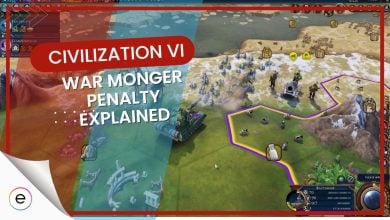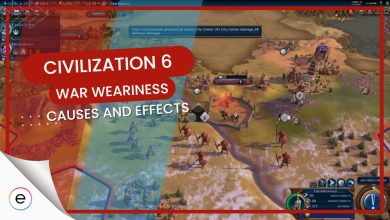When it comes to the popular strategy game series Civilization, a common debate among fans is the fierce competition of Civ 5 vs Civ 6. Created by legendary game designer Sid Meier, the Civilization series has become a staple in the world of strategy gaming, inspiring a whole generation of similar titles.
- Civ 5: Simpler gameplay, classic graphics, single-tile cities, long-term social policies.
- Civ 6: Deeper mechanics, vibrant graphics, district-based cities, dynamic government system.
- Religion more prominent in Civ 6, with religious victories.
- Diplomacy improved in Civ 6, more predictable AI.
- Civ 5 has 2 expansions, strong modding community. Civ 6 has multiple expansions, additional leaders, growing mod support.
- Civ 5 is for newcomers; Civ 6 offers a steeper learning curve.
- Civ 5 is steady-paced and strategic; Civ 6 is dynamic with added challenges.
Each game in the series puts players in control of a historical civilization and tasks them with developing their empire through various aspects such as exploration, diplomacy, technology, and military conquest. As players progress through different eras, they face different challenges, and the game’s complexity increases, offering a unique and engaging gameplay experience.
Quick differences between Civ 5 and Civ 6:
| Feature | Civilization 5 | Civilization 6 |
|---|---|---|
| Gameplay | Simpler, more accessible | Deeper, more intricate |
| Graphics | Clean, classic | Vibrant, detailed |
| City management | Single tile, straightforward | Separate tiles for districts and wonders |
| Expansions | Two major expansions | Multiple expansions, additional leaders, and growing mod support |
| Learning curve | Easier | Steeper |
| Game pace | Steady pacing and strategic planning | More dynamic with added challenges and opportunities |
Brief Overview
Civilization V and Civilization VI are the fifth and sixth main entries in the series, released in 2010 and 2016, respectively. Both games have garnered significant attention and praise from gamers and critics alike.
- Civ 5 has been credited with refining and streamlining many of the series’ core mechanics, making it more accessible to newcomers while still offering a deep strategic experience for veterans.
- Civ 6 aimed to build upon its predecessor’s success, introducing new gameplay elements and systems that provide players with even more tools to shape their empires.
As a result, both games have enjoyed large, dedicated player bases and have become the subjects of numerous discussions, comparisons, and debates.
Game Development & Release
Civ 5 was developed by Firaxis Games, a renowned studio with a long history of creating high-quality strategy titles. The game was released in the year 2010, for Windows, with OS X and Linux versions following later. It marked the series’ transition to a hexagonal grid system and introduced several new gameplay mechanics that set it apart from its predecessors.
Civ 6 was also developed by Firaxis Games and was released in 2016, for Windows, with macOS and Linux versions following shortly after. It was built upon the foundations laid by Civ 5, introducing new features like districts, a more in-depth government system, and expanded religious gameplay.
Reception By Community
Civ 5 received widespread critical acclaim for its strategic depth, streamlined mechanics, and engaging gameplay, especially its hexagonal grid system. It sold over 8 million copies by 2018, becoming one of the best-selling turn-based strategy games.
Civ 6 also received positive reviews for its bold new mechanics, like the district system and expanded government policies, adding more depth and customization. Despite tougher competition, it sold over 5 million copies by 2021.
Game Design & Mechanics

While exploring the different aspects of Civ 5 vs Civ 6, let us take a look at the game design and mechanics of each game. Under this umbrella comes the discussion on:
- Graphics & UI
- Hexagonal Tiles
- City Building
- Military & Combat
- Religion
- Diplomacy
- Espionage & Intelligence
- Wonders & Great People
Graphics & User Interface

Civ 5 introduced a more streamlined and accessible user interface compared to its predecessors. It featured a clean and minimalistic design, with easy-to-navigate menus and tooltips that made understanding game mechanics more straightforward for both new and experienced players. Civ 5’s graphics were also well-received, with Civ 5 boasting a realistic art style that captured the essence of different historical eras.
Civ 6 took a different approach, opting for a more vibrant and colorful art style that made the game feel more lively and dynamic. The user interface in Civ 6 was further refined, offering even more clarity and ease of use. The game introduced an updated “lens” system, which allowed players to access various layers of information, such as religion or appeal, with just a click of a button.
Hexagonal Tiles
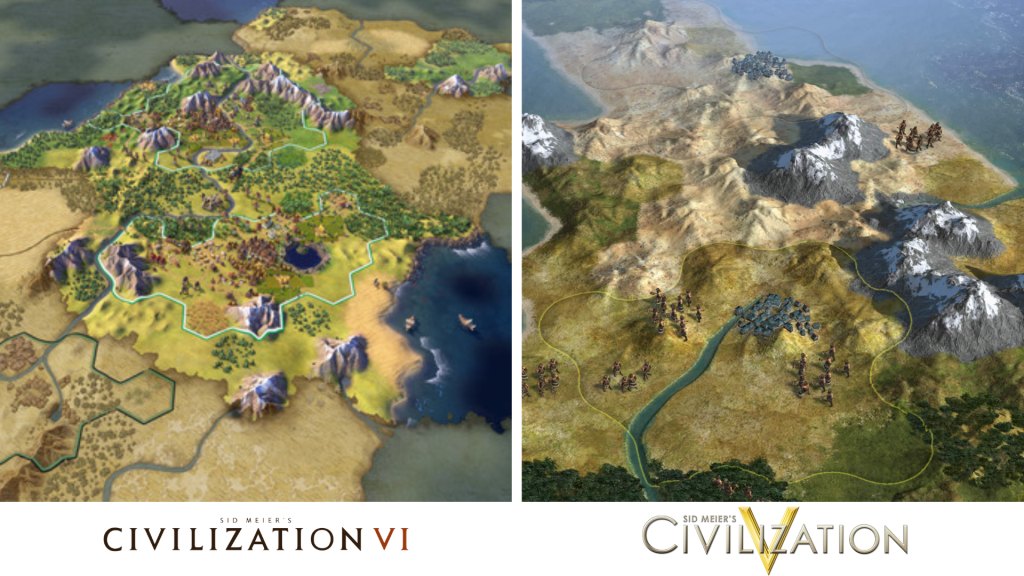
Civ 5 introduced hexagonal tiles as a significant departure from the square grid system used in previous games. This change added a new dimension to gameplay, as it allowed for more natural and varied map layouts. Hexagonal tiles also affected movement and combat, with units now able to move and attack in six directions instead of four.
Civ 6 built upon the hexagonal tile system by introducing additional strategic elements. For example, certain terrain features, such as rivers and cliffs, now played a more significant role in unit movement and combat. Additionally, Civ 6 expanded the importance of tile placement when founding cities, as adjacency bonuses, became a crucial aspect of city planning and development.
City Building & Districts
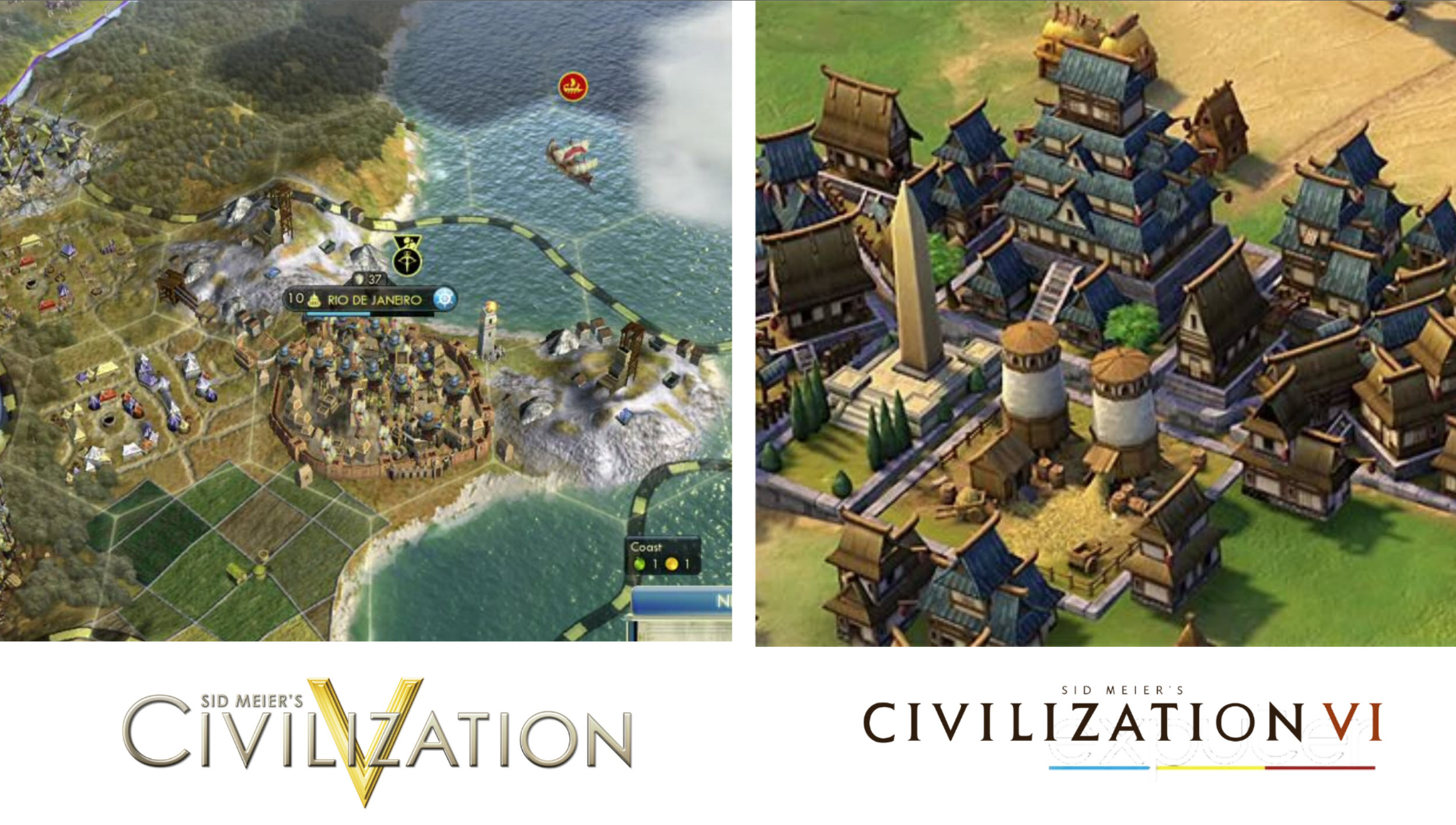
In Civ 5, city management focused on building within the city center and improvements on nearby tiles. Growth depended on food production, requiring a balance with other resources.
Civ 6 introduced districts outside the city center, specializing in development aspects (e.g., science or culture). This shift added strategic depth, considering tile placement, adjacency bonuses, and terrain, giving Civ 6 an advantage in city planning.
Military & Combat
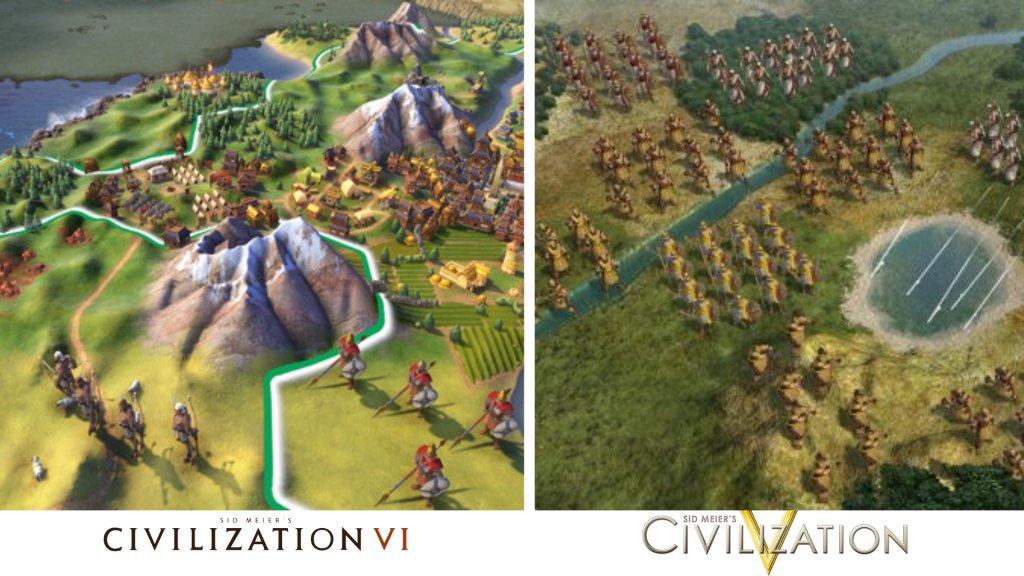
Civ 5 departed from unit stacking, allowing only one unit per tile, emphasizing tactical combat and strategy over numbers.
Civ 6 refined this system with support units like siege towers and introduced “corps” and “army” systems, enhancing unit synergy and efficiency. Civ 6’s military is considered an upgrade over Civ 5, winning this argument.
Religion & Culture
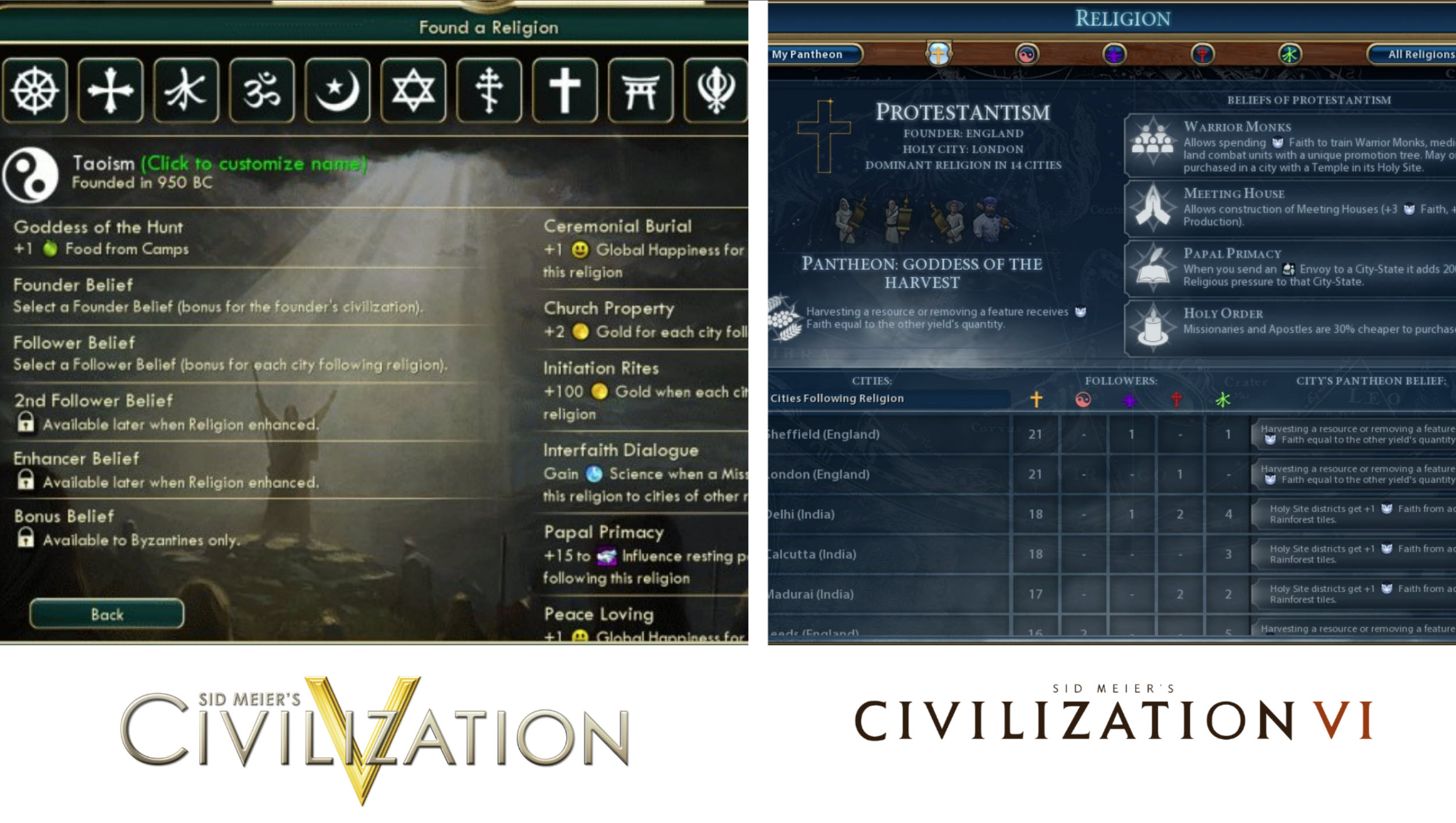
In Civ 5, religion shaped a civilization’s development through beliefs and bonuses. Religion could be spread to other cities, providing additional benefits and influence. Cultural victory was achieved through tourism and Great Works.
Civ 6 expanded religious gameplay with theological combat. Cultural victory in Civ 6 introduced “cultural victory points” based on tourism and culture, emphasizing their importance for victory.
Diplomacy
Civ 5 had a comprehensive diplomacy system with trade, alliances, and war, but AI behavior was unpredictable and opaque.
Civ 6 improved diplomacy with transparent AI agendas, helping players predict AI actions. It introduced “Casus Belli” for justifiable war, reducing diplomatic penalties for aggression.
Espionage & Intelligence
Espionage in Civ 5 was primarily focused on gathering intelligence about rival civilizations and stealing technologies. Players could train and assign spies to infiltrate foreign cities, where they could monitor enemy activities, steal technologies, or even rig elections in city-states to gain influence.
Civ 6 expanded upon the espionage system by introducing new spy missions and additional counter-espionage options. In Civ 6, spies can perform a variety of missions, such as:
- sabotaging enemy production
- stealing Great Works
- disrupting enemy space projects
- assigning spies to protect their own cities and counteract enemy espionage activities
This enhanced espionage system adds another layer of depth and strategy to the game, as players must carefully manage their spy networks to gain an advantage over rival civilizations.
Wonders & Great People
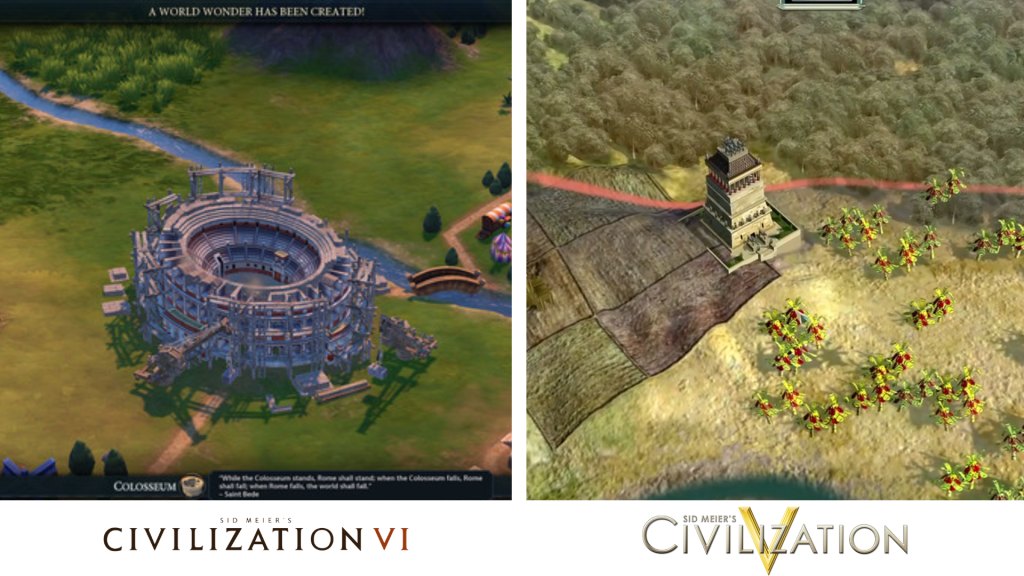
In Civ 5, players could build World Wonders with powerful bonuses, often requiring significant production investment. Natural Wonders were strategic choices.
Civ 6 continued World Wonders with specific tile-placement requirements for added strategy. It introduced a Great People system, each with unique abilities, enhancing resources, military, or culture. Both games offer immersive turn-based strategy experiences.

AI & Difficulty
In Civilization games, the AI is pivotal in shaping the overall gameplay experience since it governs the actions of competing civilizations, city-states, and barbarians.
In Civ 5, the AI provided a challenging experience but faced criticism for occasional irrational decisions, military prioritization, and struggles with the hexagonal grid system. It was also passive diplomatically.
Civ 6 aimed to address these issues with an AI agenda framework, making AI behaviors more nuanced and adaptable. However, challenges remain, such as AI struggles with military tactics and city management.
Despite these remaining issues, Civ 6’s AI represents a step forward in terms of difficulty and realism compared to its predecessor. Firaxis Games has continued to address AI concerns through patches and updates, demonstrating their commitment to refining the AI experience in the Civilization series.
Expansions and DLCs
Expansions and downloadable content (DLCs) play a crucial role in enriching the Civilization gaming experience, adding new features, mechanics, and content that breathe fresh life into the core gameplay.
Civ 5

Civ 5 received two major expansions, which significantly enhanced the game’s depth and introduced new gameplay mechanics:
- Gods & Kings (2012)
- This expansion introduced religion as a core gameplay mechanic, allowing players to find their own religions and spread them across the world.
- Additionally, Gods & Kings revamped the combat system, added new technologies, and introduced new civilizations, leaders, and units.
- Brave New World (2013)
- Brave New World focused on enhancing the cultural and diplomatic aspects.
- It introduced the tourism system, enabling cultural victories by attracting visitors to a civilization’s cultural wonders.
- The expansion also added the World Congress, which allowed players to participate in global politics and vote on resolutions that could impact all civilizations.
- Furthermore, it brought new civilizations, leaders, units, and wonders to the game.
Civ 6

Civilization 6 also received two major expansions, which built upon the base game’s mechanics and added new features:
- Rise and Fall (2018)
- Rise and Fall introduced the concept of Ages, where a civilization’s performance could lead to either a Golden Age or a Dark Age, with various bonuses and challenges.
- The expansion also added Loyalty, which affected city stability and could result in cities rebelling or being peacefully assimilated. It also brought new civilizations, leaders, units, and wonders.
- Gathering Storm (2019)
- Gathering Storm focused on environmental and climate aspects, adding natural disasters, renewable energy sources, and the World Climate system.
- The expansion also included the World Congress, similar to Civ 5’s Brave New World, and introduced the Diplomatic Victory condition.
- Additionally, it added new civilizations, leaders, units, and wonders.
Comparison
Both Civ 5 and Civ 6 benefited from their expansions, enhancing different aspects of gameplay. Civ 5 focused on religion, culture, and diplomacy, while Civ 6 introduced age, loyalty, and environmental mechanics.
The preference for expansions depends on gameplay style. Civ 5’s Brave New World suits those who enjoy diplomacy and culture, while Civ 6’s Gathering Storm appeals to those who like dynamic worlds and environmental challenges.
Ultimately, the better expansion is subjective, and players can choose based on their gameplay preferences, as both offer rich experiences.
Personal Experience
As an avid fan of the Civilization series, there are several aspects of both games that we, at eXputer, particularly appreciate the most.
Civ 5
First and foremost, the introduction of the hexagonal grid system in Civ 5 was a game-changer, adding a new level of strategic depth to the game. The hex grid made the movement and positioning of units more engaging and allowed for more interesting tactical decisions in combat.
The World Congress and Diplomacy system in Civ 5, especially with the Brave New World expansion, added an engaging political layer to it. It allowed for more dynamic interaction with other civilizations and provided additional avenues for players to pursue victory through diplomacy and cooperation.
Civ 6
Civ 6 introduced several captivating features that appeal to players, making it a rewarding and challenging experience:
- The district system added complexity to city planning, offering a puzzle-like experience with adjacency bonuses.
- The combined civic and tech tree provides a robust progression system, rewarding various aspects like exploration, combat, and culture.
- The government and policy system allows deep customization, letting players adapt and experiment with strategies for dynamic gameplay.
Civ 5 may be more relaxed, while Civ 6 offers a greater challenge. Both games cater to different preferences, providing strategic depth and innovation for strategy game enthusiasts.
Up Next
Thanks! Do share your feedback with us. ⚡
How can we make this post better? Your help would be appreciated. ✍
